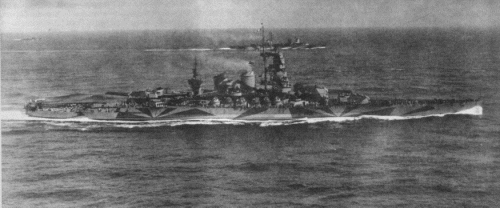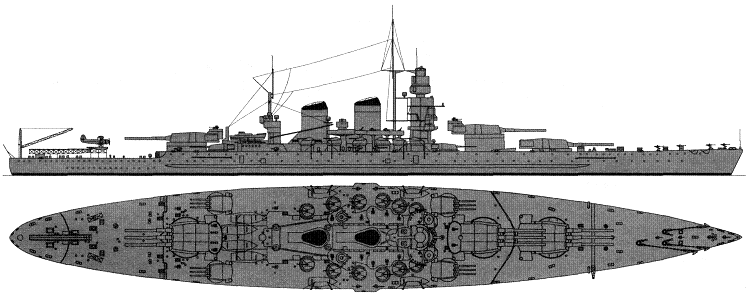
NAVYPEDIA
 Support the project with paypal
Support the project with paypal
Photo

Vittorio Veneto 1943
Ships
| Name | No | Yard No | Builder | Laid down | Launched | Comp | Fate |
|---|---|---|---|---|---|---|---|
| Vittorio Veneto | CRDA, Trieste | 28.10.1934 | 22.7.1937 | 28.4.1940 | stricken 1.1948 | ||
| Littorio, 7.1943- Italia | Ansaldo, Genoa | 28.10.1934 | 22.8.1937 | 6.5.1940 | stricken 6.1948 | ||
| Roma | CRDA, Trieste | 18.9.1938 | 9.6.1940 | 14.6.1942 | sunk 9.9.1943 | ||
| Impero | Ansaldo, Genoa | 14.5.1938 | 15.11.1939 | --- | captured incomplete 10.9.1943 |
Technical data
| Displacement standard, t | Vittorio Veneto: 40517 Littorio: 40724 Roma: 40992 |
|---|---|
| Displacement full, t | Vittorio Veneto: 45029 Littorio: 45236 Roma: 45485 |
| Length, m | Vittorio Veneto, Littorio: 224.1 pp 237.8 oa Roma: 224.1 pp 240.7 oa |
| Breadth, m | 32.8 |
| Draught, m | 9.60 at standard load |
| No of shafts | 4 |
| Machinery | 4 sets Parsons geared steam turbines, 8 Yarrow boilers |
| Power, h. p. | 128200 |
| Max speed, kts | 30 |
| Fuel, t | oil 4140 |
| Endurance, nm(kts) | 4700(14) |
| Armour, mm | belt: 280 + 70, bulkheads: 210 - 70, turrets: 350 - 280, barbettes: 350 - 280, secondary turrets: 280 - 50, CT: 260, main deck: 162 - 90, upper deck: 45 |
| Armament | Vittorio Veneto: 3 x 3 - 381/50 Ansaldo 1934, 4 x 3 - 152/55 OTO 1936, 4 x 1 - 120/40 Armstrong 1891, 12 x 1 - 90/50 OTO 1939, 8 x 2 - 37/54 Breda 1938, 4 x 1 - 37/54 Breda 1939, 8 x 2 - 20/65 Breda 1935, 1 catapult, 3 seaplanes (Ro.43, Ro.44) Littorio: 3 x 3 - 381/50 Ansaldo 1934, 4 x 3 - 152/55 Ansaldo 1934, 4 x 1 - 120/40 Armstrong 1891, 12 x 1 - 90/50 OTO 1939, 8 x 2 - 37/54 Breda 1938, 4 x 1 - 37/54 Breda 1939, 8 x 2 - 20/65 Breda 1935, 1 catapult, 3 seaplanes (Ro.43, Ro.44) Roma: 3 x 3 - 381/50 Ansaldo 1934, 4 x 3 - 152/55 OTO 1936, 4 x 1 - 120/40 Armstrong 1891, 12 x 1 - 90/50 OTO 1939, 8 x 2 - 37/54 Breda 1938, 4 x 1 - 37/54 Breda 1939, 14 x 2 - 20/65 Breda 1935, 1 catapult, 3 seaplanes (Ro.43, Ro.44, Re.2000) |
| Complement | 1830 - 1950 |
Standard scale images

Littorio 1940

Littorio 1941
Graphics
Project history
Project history: Designing of Vittorio Veneto class battleships has begun in Italy still in the early thirties, practically simultaneously with works on modernization of Andrea Doria and Conte di Cavour classes under the guidance of main fleet designer general Pugliese. First two ships, Littorio and Vittorio Veneto, were built under 1934 programme. Though at the moment of laying standard displacement of battleships according to limitation of Washington Treaty should not exceed 35000t, at Italian battleships this value has increased at once on 5000t, as for a design stage it was found out what to create the balanced ship in Treaty limits was unreal.
Proceeding from possibilities of the national industry as main calibre there were chosen not resolved 406mm guns, and designers were stopped on 381mm guns. Italians have tried to indemnify smaller calibre by higher muzzle velocity, however for it it was necessary to pay a fast wear of a barrel and, as consequence, decrease in accuracy of fire. Extraordinary high arrangement of an aft turret in attempt to save a catapult being on a quarter-deck from influence of powder gases at aftward fire began interesting feature of the ships.
The protection which was traditionally considered as a weak place of the Italian ships, on Vittorio Veneto was extremely strong. Armoured belt on a waterline in 3.8m height (1.5m underwater in full loaded condition) had a declination outside 11° and consisted of external 70mm layer and distant from it on 0.25m main 280mm layer. Further deeper into hull through 1.4 m there was 36mm main armoured longitudinal bulkhead installed under the same angle, as a belt. At last, even closer to a centre line there was last barrier: 25mm second armoured longitudinal bulkhead, but already raked inside. Total horizontal protection, thus, made 409mm. The side above a belt also was protected and had 70mm thickness, (45mm at fore end). Extremely thick there was an armour deck: to 162mm over magazines and 100mm over machinery.
Anti-torpedo protection of Pugliese design very much resembled on applied on modernized battleships, but was deeper and had thicker elements. Horizontal armoured 40mm deck, adjoining by one end to lower edge of an armoured belt, on some removal was bent on the big radius downwards and transferred to vertical 40mm bulkhead connected with a double bottom. In formed by this bulkhead and outer side plating space along the hull pulled a pipe in about 3.8m diameter with 6mm walls thickness. At filled with water or fuel compartment and remaining empty pipe the latter at torpedo hit played a role of wrecked absorber of explosion energy as was softer than construction ambient it. Underwater protection was been calculated for resisting to explosion of torpedo with 350kg TNT.
At rather strong protection Vittorio Veneto class ships have appeared one of the fastest battleships in the world, obviously yielding only last American ones. On trials both first ships more than on 1kt superimposed contract speed, and during daily service their speed exceeded 28kts.
The following pair, Roma and Impero, was built under the 1938 program. For improvement of seaworthiness a forecastle deck received some rise fwd, that has a little increased length oa. Completion of the second ship was not been finished: in September, 1943 her hull was captured by German troops and 20.2.1945 sunk by Allied aircraft at Trieste.
Ship protection
Main belt between end barbettes was 3.8m high and inclined at 11° outward. It contented of 70mm outer layer and 280mm inner layer with 0.25m spacing between. 36mm main splinter longitudinal bulkhead placed in 1.4m from main belt inside hull. Second 25mm splinter longitudinal bulkhead was inclined at 27° inward. This belt was closed by 200mm fore and 280mm aft bulkheads, thickness of these bulkheads was decreased to 70mm under main deck. Thickness of main deck outside end barbettes was 70mm at fore and 130-100mm aft parts. Ship side over main belt was protected by 70mm armour between end barbettes and by 45mm between barbette No 1 and stem.
Flat main deck was connected with upper edge of main belt and consisted of 100mm (90mm near side) armour on 12mm plating (150mm on 12mm plating over magazines). Lower 100mm armoured deck with 100mm slopes protected aft ship part between aft bulkhead and stern. Forecastle deck consisted of 36mm armour on 9mm plating.
Barbettes of main gun turrets had 350mm protection over and 280mm under forecastle deck. Turrets had 350mm faces and 200mm sides, rears and roofs. Secondary turrets had 280mm faces, 130-80mm sides and rears and 150mm (first pair) - 100mm (aft pair) roofs. Their barbettes had 150mm armour over forecastle deck and 100mm under. Fore superstructure had 60mm protection and CT had 260-210mm armour.
Underwater protection of Pugliese design included 40mm curved lower deck came to vertical 40mm longitudinal bulkhead connected with double bottom. Inner 3.8m diameter tube had 6mm sides.Underwater protection was 7.6m deep and could resist exploding of 350kg TNT.
Modernizations 9.
1941, Littorio: + EC-3/bis radar
spring 1942, Vittorio Veneto: + 8 x 2 - 20/65 Breda 1935
spring 1942, Littorio: - EC-3/bis radar; + 6 x 2 - 20/65 Breda 1935, EC-3/ter radar
6/1943, Vittorio Veneto; 8.1943, Roma; 9.1943, Littorio: + EC-3/ter radar
Naval service
Littorio was hard damaged during British carrier aircraft raid 11.11.1940 to Taranto: she received three torpedo hits and was under repair till April, 1941. Vittorio Veneto was damaged by aircraft torpedo in battle at Matapan and was under repair till August, 1941. In December, 1941 she was damaged by torpedo from British submarine Urge and was under repair till March, 1942. 30.7.1943 Littorio was renamed Italia. At a passage of the Italian Navy to Malta Roma received 2 hits of SD-1400X guided bombs launched from German Do 217 bomber. Hits have called a fire and amunition explosion, battleship was sunk Wt of Bonifaccio channel. In the same campaign Italia was damaged as a result of hit of a similar bomb.
 HOME
HOME FIGHTING SHIPS OF THE WORLD
FIGHTING SHIPS OF THE WORLD ITALY
ITALY CAPITAL SHIPS
CAPITAL SHIPS VITTORIO VENETO battleships (1940 - 1942)
VITTORIO VENETO battleships (1940 - 1942)
